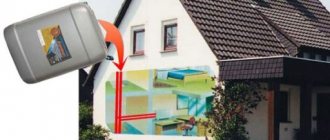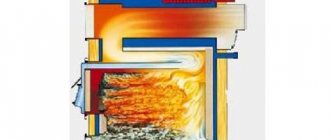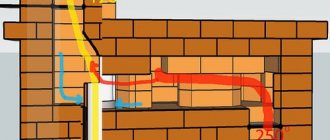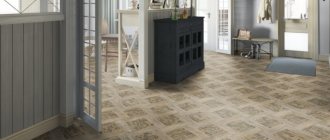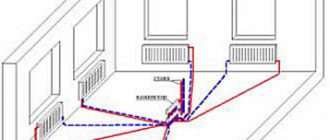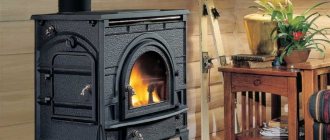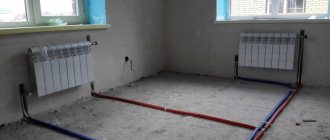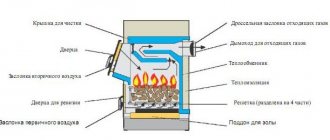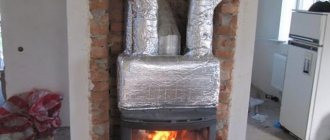Types of furnaces
Top combustion products come in different types. According to their purpose, they are divided into kitchen and heating. According to the type of heat source used - gas, electric, wood. Based on the main material, hearth products are either metal or brick. Let's look at the features of different types.
Kitchen
As the name suggests, these ovens are designed for installation in the kitchen and subsequent cooking on them (baking bread, confectionery). It can be as simple and miniature as possible, suitable for private homes. For restaurants and bakeries, there are functional and production models on sale that allow you to prepare many dishes at the same time.
Gas
Inside the housing there is a burner and ring-shaped pipes (up to 19 pieces) through which gas passes. There are 2-5 tiers inside, for each the temperature is regulated separately. The maximum operating temperature in gas stoves is 300 degrees. You can work with her around the clock. The energy created by the burner passes through three circles: in the first, it directly heats the area near the burner; in the second and third circles, the pipes and bricks that form the bottom and walls of the furnace are heated with flammable gas. The heated parts begin to distribute uniform heat.
Design example
Electrical
Externally, gas and electric hearth ovens are no different. The differences lie in the “filling”. Inside, instead of a gas burner and pipes, there is a heating element (in the upper and lower tier it is possible to arrange the turns of the heating element in the center)
As in gas ovens, electric ovens can have from 2 to 5 independent chambers. The temperature inside each chamber may be different, allowing you to cook different dishes.
From a financial point of view, gas is a more economical fuel, but from the point of view of safety and ease of control, electric furnaces will be more profitable.
Wood burning
A wood-burning hearth oven was used by our ancestors. True connoisseurs believe that food made from it will be much tastier than that made on an electric or gas stove. The light aroma of wood adds a zest to the dishes. Cons: The wood stove is the most difficult to use. You have to manually add fuel and monitor its burning.
Heating
The difference between heating stoves and kitchen stoves is their single-chamber design - there is no need to create separate zones for kitchen baking sheets. In Europe, a hearth-type stove is the only permitted heating structure inside residential buildings. This is explained by the safety and environmental friendliness of the system - in a deck stove the fuel burns out completely; There is no exhaust of smoke polluting the atmosphere through the chimney.
Metal
For the manufacture of such stoves, cast iron or steel alloy is used. The advantage of the design is simple installation and maintenance. The downside is that the body gets very hot, so you can get burned if you touch it. The service life with proper operation is 30-50 years. Minus - metal stoves do not tolerate sudden changes in temperature, which can cause them to crack.
Brick
Such a stove accumulates (accumulates) heat better and releases it longer. It looks very impressive, so it will decorate any classic interior. It lasts twice as long as a cast iron or steel structure, but it costs an order of magnitude more. Installing a brick stove is difficult; it is better not to install it yourself without specialists.
Expert opinion
Pavel Kruglov
Stove maker with 25 years of experience
The downside is the lack of portability - after installation it will not be possible to quickly move it to another place (you will have to completely disassemble the structure).
Beautiful brick hearth oven
Why is it profitable to heat with wood?
Not all settlements in our country are gasified. Therefore, for many homeowners, the problem of heating their homes is quite acute. Electricity is not always suitable as a heat source because it is very expensive. An electric heater will save the day when it comes to a country house, where you need to visit no more than once or twice a month. Moreover, it does not require special installation or complex maintenance. Constantly heating a house with electricity is very expensive and will require a lot of money.
Heating units running on liquid fuel are not popular due to a lot of disadvantages. You need to buy diesel fuel. This needs to be done in large volumes to make it cheaper, which means there is a question of storing it. It is impossible to get rid of the smell of diesel fuel; gradually it will take over the entire room. There are, of course, advantages - for example, the ability to work in automatic mode.
The cheapest and most accessible option is firewood. You can buy a whole truckload of this fuel very cheaply. Sometimes there is an option to get firewood for free if you heat the stove with wood waste, and it is possible to chop firewood in the forest.
On a note. The quality of the wood that will be used is also of great importance. Each type of wood has its own special density in structure. The denser it is, the longer it will burn, then smolder in the combustion chamber. Usually they have two types of firewood - with a dense structure and light, in order to speed up the ignition process. To ensure that the quality of the wood does not suffer, it must be stored properly.
Installation work
The chimney is an important element of the Buleryan stove. The best option in this case is to install a heat-insulated chimney. This is due to the fact that the gases leaving the device have a low temperature. As a result, condensation forms. Insulated structures positively solve this problem.
- smooth surface;
- channel of optimal shape;
- high resistance to corrosion and temperatures;
- durability, low weight;
- easy installation.
Drawing of the Buleryan stove.
If the chimney is made of brick, then the thickness of its walls should be more than 120 mm. For concrete structures this figure is more than 60 mm, for metal structures - more than 1 mm. The chimney outlet is carried out on buildings with a roof made of non-hot material 1-1.5 m above the ridge. If this element is located inside the building, then it needs thermal insulation, which is carried out using mineral wool with a thickness of more than 200-250 mm.
At the base of this element there is a removable panel or hole with a door for cleaning. During the heating season, Buleryan is cleaned at least 2 times.
Schematic diagram
When the unit is operating, oxygen for afterburning is taken from the combustion chamber. In this case, the proportion of air that is taken from the firebox changes mechanically. Its quantity depends on the quality of the fuel used and the set combustion mode. This distinguishes Buleryan from all systems with connected or separate air flows.
The space separated by an upper partition forms an afterburning chamber when operating in smoldering mode. Flue gases from the afterburner are discharged into a “hog” or “pig”. This part of the chimney is placed horizontally, and its length is 0.8–1 m. The use of a hog is mandatory, since it slightly stops the combustion of the gases that escape.
In the chimney after turning there is a damper, or smoke choke. There is no view that completely blocks the chimney, so there is no danger of burning. The diameter of the chimney is slightly larger than the blower pipe, and a hole is made in the damper, so carbon monoxide will in any case go into the chimney pipe. An economizer is located on top of the gate in the furnace.
Element names
Having studied the drawing of the buleryan, you can see that its structure is a vertically located section of the chimney. Its length is from 1.5 to 3 m. The final combustion of fumes occurs in it. In the hog, the middle of the gas stream does not have time to cool, and the IR reflected from the walls of the economizer increases the concentration of thermal energy in the flow, so a gas flash occurs.
The gas that has flared up increases in volume, but in a closed space it has nowhere to go, so a gas lock is formed. In this case, the combustion in the furnace firebox subsides, the plug cools and passes out, and the combustion intensifies again.
We suggest you read: Backdraft in the chimney, what to do and causes of occurrence
Counterflow furnaces
The most advanced type - efficiency can reach 90%. Such an impressive figure is possible thanks to the original design, in which the chamber with an open fire is separated from the chimney by a wall. As a result, the smoke is removed through the lower part of the stove, and the room is heated evenly.
It seems impossible - hot air always rises! This is true. But the device has a special hood in which the smoke accumulates and cools. Cold gas particles move down and are removed through the chimney, and heated air enters in their place. This achieves high efficiency.
Vimana stove
Such heating stoves have a number of advantages:
- the ability to construct devices of any size and shape;
- a water heater, oven or steam generator can be installed in the hood;
- there is a prospect of automating the process.
Vimana stoves, retrofitted with an air recirculation system, can even be used in apartment buildings. Their only drawback is the complexity of the design. Not every master can build this variety.
Grum-Grizhimailo stove
Another counter-flow design, developed by the Russian stove maker-inventor V.E. Grum-Grizhimailo. It has a round shape, so it can be styled like a Dutch oven (which is what enterprising Russian stove makers have been doing for the last 150 years). Its operation is based on the principle of free movement of gases.
In the middle of the firebox there is a hailo - a hole through which gases penetrate into the upper part, over which the hood is located. Heat transfer occurs in this section, the cooled gas descends, and the heated air rises.
The Groom-Grizhimailo device perfectly accumulates heat - the temperature in the room does not drop even if the stoker forgot to close the valve. Cold air entering the furnace through the ash pan does not allow the hot streams to cool and therefore the device gives off heat for a long time, despite the relatively thin walls.
What mortar should I use for masonry?
The reliability and durability of the finished stove directly depends on the quality of the masonry mortar. The masonry will be carried out using a sand-clay based mortar.
There is nothing complicated in preparing the solution. Take clay, fill it with water and soak it. Sift the mixture through a sieve and then stir into “clay milk.” Finally, add some water to obtain a sufficiently viscous and plastic solution.
Fireclay clay
Remember, the reliability and strength of the stove directly depends on the correct preparation of the masonry mortar. If you do everything right, the stove will effectively heat your home for many years. Violate the technology or decide to save a lot on materials - the thermal unit is unlikely to be able to fully reveal its potential and stand for any length of time.
Mortar used for laying the stove
Popular wood stove models
Model range of stoves Professor Butakov
In order not to waste time and money on building a massive brick structure, you can purchase a ready-made potbelly stove, heating and cooking or sauna modification. Several brands are popular in the domestic market.
Burelyan
Canadian device with ducted heating system. The powerful stove is suitable for installation in a home, utility room, workshop, or garage. Works on all types of solid fuel, with the exception of coal. It heats up in 10-15 minutes, the second load of firewood can be done after 8-10 hours.
Breneran
Russian brand that released the AOT-08 model. The floor-standing wood burning unit is equipped with a long combustion system. Installed in residential buildings, workshops, workshops. The firebox has a volume of 50 liters, which is suitable for heating a space of 140 m2. Thermal power is 8 kW, the second loading of firewood is carried out after 10-12 hours.
Professor Butakov
Notable design features are a rectangular body, an internal firebox, the presence of a pyrolysis afterburning chamber and convection pipes. The intensity of air supply is regulated by a damper. The line includes 4 devices:
- Student with a power of 9 kW and a firebox of 60 liters.
- Engineer - equipped with a 120-liter firebox and a power of 15 kW.
- Associate Professor - a stove with a thermal power of 25 kW and a firebox capacity of 250 liters.
- Professor - power is 40 kW, firebox volume is 500 liters.
The cooking surface is flat, suitable for heating food.
Termofor
Termofor stoves of the domestic brand
. A Russian brand that produces convection units of the Fire-Battery brand. The selection of the unit is carried out according to several parameters:
- Fire-Battery 5 – with a width of 37 cm, a length of 55.5 cm and a height of 76 cm, it has a power of 6 kW. Designed for heating rooms with a volume of 100 cubic meters and an area of 60-70 square meters.
- Fire-Battery 7 – differs from the previous model in length (68 cm), power (10 kW). It efficiently heats a house of 100-110 m2 and a room of 150 m3.
- Fire-Battery 9 – power is 13 kW. The length of the device is 80.5 cm. It is installed in houses of 130-10 square meters and rooms with a volume of 200 cubic meters.
- Fire-Battery 11 is a modification with a length of 93 cm. Designed for heating a space of 250 m3 in volume and an area of 160-170 square meters.
The digital index in the name of the Fire-Battery ovens indicates the number of convection pairs.
Vira
Sauna stoves Vira
Heaters made of heat-resistant steel with an elongated body and convection shielding. The firebox is trapezoidal, the chimney 115mm in diameter is located in the center or near the front. The line includes models:
- Nika 10. Shifting the chimney to the front wall improves heat transfer. The sauna stove is designed for a steam room with a volume of 10 m3. The weight of the stones is 28 kg.
- Vira 12. Classic device for a sauna with a volume of 12 cubic meters. Depending on the configuration, the sash is made of metal or panoramic glass. The weight of the stones for laying is from 41 to 50 kg, the length of the logs is from 40 to 50 cm.
- Castle 18. The complex shape of the smoke tooth increases the efficiency of the furnace by 4-5%. The walls at the back and front are detachable, the firebox is of remote type. Designed for a steam room of 18 cubic meters. Stones weighing 48 kg and firewood 50 cm in length are placed in the oven.
- Nova 12. Equipped with a heater without sharp corners, connected to the front wall. Suitable for steam rooms of 8-12 m3. The maximum weight of stones is 37 kg.
The manufacturer also produces devices with steam generators equipped with a closed heater.
The variety of modern wood-burning stoves allows you to choose an option for heating and cooking, installation in a bathhouse or sauna. The devices differ in body materials, power ratings and fuel combustion duration. Popular auxiliary functions include a stove bench, hob, water circuit and oven.
Types of solution
Laying a Russian stove with your own hands requires the preparation of a specific solution. The mixture for this can be purchased ready-made, or you can prepare it yourself according to a unique recipe.
Clay mortar
This type of mortar involves individual formulation for different types of bricks.
Laying pipes in the attic
For laying solid bricks, a sand-clay mortar is used. The same solution is necessary for lining the stove with ceramic tiles.
To lay refractory bricks, you will need a mortar prepared from a mixture of refractory clay and sand.
Fireclay bricks are laid using a mortar consisting of fireclay powder and refractory clay.
Laying a chimney in the attic is done using a mortar based on cement and sand.
Masonry mortar
The main problem when preparing a mortar for masonry is drawing up the optimal proportion of its components and choosing clay of the required quality. All types of clay have certain qualities, which vary depending on its type. There are lean and fatty clays. To determine this parameter, you need to get a small ball from it and try to crush it between the boards. If cracks begin to appear before the material is crushed to a third of its diameter, the solution is considered lean and requires additional clay. If cracking begins later, then the solution is greasy and sand should be added to it. A solution that is richer is preferable to one that is too dry.
Solution
To prepare the solution you will need a container made of metal. The clay is soaked in this container for two days. Then sand is added and the solution is mixed using feet previously shod in high rubber boots. To obtain a homogeneous solution, it is necessary that there are no lumps or stones in it.
How to choose a stove for a red brick house - photo
If we are talking not only about heating, but also about complementing the interior, you can give preference to a round Irish stove. The thickness of the walls is ¼ stone. To give additional strength and increase heat transfer, a metal frame is “put on top”. It will strengthen the masonry and allow you to decorate the outer surfaces with forging.
If there are always people in the building, and there is a desire to cook food on wood or coal, you should choose a square or rectangular design, for example, Russian or Swedish. If you need a fireplace more as a stove for your home, pay attention to thin-walled Dutch or round Irish stoves. They are ideal if you don't need a special cooktop. And the front surface can be decorated with elegant tiles. They can become both an addition to the interior.
Do you want to stop using a gas stove? Variations of the Swede are at your service. They will warm you up and allow you to brew coffee over an open flame. The main thing is to correctly lay out and select the source materials.
Where to place the stove in the house
The main focus is on the design phase. The quality of the drawings determines the safety, performance properties, and aesthetic appeal of heating equipment. If you don’t have your own drawing skills, it’s better to turn to professionals. When choosing a place for placement, both the type of heater itself and the area of the cottage or part of it that is planned to be heated are taken into account.
Selection of working tools
Then you can move on to the tools. For work you will need:
- jointing With its help, concrete is poured into the seams;
- trowel;
- pick;
- shovel for mixing and supplying the solution;
- special line.
Materials
The next stage is purchasing the material. The heat transfer of the stove and its durability will depend on the quality of the brick. The rules are as follows:
- the outer surface is made of brick (grade M-500). They do not crack, do not lose their consumer properties during periodic heating or cooling;
- Only refractory bricks are suitable for the combustion chamber.
In addition, you will need sifted sand and high-quality clay.
Laying the foundation
Materials have been purchased. You can move on to the construction stage. It is important to understand that the stove must stand on a strong and high-quality foundation. It is better to lay it at the same time as the base of the entire house.
If the decision to build a Dutch or Swedish one is made only now, you will have to:
- dig a hole. On each side there should be at least 20 cm to the walls;
- level the bottom and fill it with sand, followed by thorough compaction;
- lay a waterproofing membrane;
- install formwork;
- pour concrete (1 part cement x 2.5 parts sand x 4 parts small crushed stone) to ground level. The surface of the foundation must be strictly horizontal;
- wait 5-6 days for the concrete to harden. After this, you can disassemble the formwork and lay waterproofing.
If, as a result, the foundation ends up below the floor level, it is leveled by additional pouring of concrete mixture. In the latter case, the formwork is rebuilt. The entire space around the foundation is filled with soil and thoroughly compacted.
Masonry process
First, a mixture of sand and clay, previously soaked, is prepared. It fills the gaps between the outer and inner walls. They are displayed separately, but there should be no spaces between them. The lowest rows are only made of solid brick and with a sling. Then the brick is cut taking into account the selected modification. The chopped side faces the inside of the masonry. To build a chimney you will need red burnt stones. Knowing the “castle” layout will not be superfluous. A brick chimney must be lined with a FERRUM stainless steel chimney to prevent the formation of condensation and premature destruction.
Is the oven built? There is no need to rush to melt it. You must wait at least 3 weeks.
Cast iron stoves with water circuit
Cast iron stoves with a water circuit are produced in different capacities and are designed for heating different areas. Some of them are capable of heating a two- and three-story house. The heating circuit is constructed using the same system as for brick stoves.
Long-burning cast iron stove with heating circuit
Furnaces are produced from cast iron and combined type, i.e. having electric heating, which turns on automatically when the temperature of the smoldering firewood decreases. This combination of oven functions will always help maintain the heating system at the desired temperature.
One of the possible heating schemes for a two-story private house
Cast iron boiler-stoves can also be designed for a double-circuit heating system, i.e. In addition to the warmth in the house, the owners will also have heated water.
What should you consider when choosing and installing a stove?
When choosing which heating stove will be installed in the house, you need to correctly formulate the requirements for it, and, based on them, purchase or build a heating device.
- The heating properties of the entire brick kiln structure are very important. Therefore, if you decide to install such a stove, you need to choose the right project and ensure the ideal construction of the building.
- The efficiency of the heating system will also depend on the design and layout of the water circuit, as well as the choice of radiators for the heating system. There are stove designs that can operate in summer and winter mode - this factor also contributes to the economical operation of the device.
- Part of the savings can be attributed to the long cooling of the furnace, which will allow you to use less fuel.
- An important point is ease of operation and maintenance.
- The structure must comply with all fire safety rules for its location and installation.
- A properly executed design will have the required draft, which will protect the house from carbon monoxide entering the premises.
- The stove must be designed for a long period of operation.
- Of course, it would be nice for the stove to become a real decoration of the home, and not just be functional from a practical point of view.
Selecting a heating system
A small, well-insulated house with 1-2 rooms can be heated with one heating and cooking stove made of brick. For a larger building, you need to decide what type of heating system to choose so that one stove heats the entire house. Steam, water or air circuits can be used for this. In a one-story building, the system can be connected to a brick stove. For a two- or three-story house, the best option is a stove-boiler made of cast iron.
Read more: cast iron furnace casting.
Heating a house without gas:
You need to decide on the type of fuel. It can be firewood, coal, peat, gas, diesel fuel, electricity. This choice determines what type of stove to purchase or make yourself.
DIY house layout
Watch another master class. From it you will learn how to make a house inside and outside, as well as a platform for it.
The model of the hut is made of cardboard. For the roof, cut out two rectangles and glue them at the top with a strip of the same length. You will get a gable roof. It can be painted to resemble tiles. Make the frame of the house from a wide strip of cardboard, from which you need to create a square. First, you will paint the outside of it so that it is clear that it is a log house.
Glue wallpaper inside so that it also resembles wood. Place your creation on the prepared platform, onto which a green leaf is glued. Make a canopy over the entrance from cardboard. We will also make a Christmas tree from this material. You can paint light cardboard green or take material that is already that color. Also make a tree and attach it here.
To make a well, use the same material. Make logs out of painted cardboard and assemble them. Take two sushi chopsticks. Saw off a piece from one. Connect these two sticks using a metal chain to form a crane well. You can also place fruit trees here.
Now look at what the layout of the hut looks like inside. It’s interesting to create it with your own hands. Cover the floors with wood-look film, make the stove out of cardboard. Make a mat out of brown cardboard that needs to be glued to a horizontal surface.
See what the layout of the house and yard looks like from above. You can paint the path so that it is brown or glue paper of that color. Glue several fruits cut out of colored paper onto the apple tree.
Make the house more comfortable. Glue curtains or tulle to the windows. You can also fence off the stove area in the living room. Make a bed out of cardboard and place bedding here. Examine the table. Place a samovar, and the child can mold plates and food from plasticine, like a chest, and small household items.
If you need the most reliable model of a hut, then make a canopy here, which was a kind of corridor at the entrance to the house. Make a wall out of cardboard, cover it with self-adhesive film, cut out doors that will open.
Here's how to make a mock-up of a hut. See how others do this kind of work.
You can make it out of paper, as the heroine of the next video does.
Related article: How to make a model of a village and city
What is the oven made of?
Durable steel or cast iron are good options for making stoves. They have excellent heat transfer and, what is very important, they warm up the room very quickly. If previously there was no worthy alternative to brick stoves, today the advantages of metal models have already been appreciated by many owners of houses and summer cottages.
The heating surfaces of cast iron units have a temperature several times higher than brick stoves for a wood-burning home. They are compact and safe if the operating requirements are met.
Cast iron ones are heavier than steel ones; they need to be placed on a permanent foundation. But they have a great advantage - they can accumulate heat and withstand high temperatures. They are more durable. The most interesting models in design are made from cast iron.
Preparatory work
The weight of the stove is considerable, so they make a full-fledged concrete foundation using formwork:
- Mark the location of the furnace. It is necessary to ensure that the door and window are not on the same line and provide a chimney outlet. The size of the foundation will be 15-20 cm larger than the dimensions of the stove. Using a grinder, dismantle the wooden floor covering.
- Formwork is arranged and the foundation is poured with concrete (the upper level should not reach the floor surface by 2 bricks). Concrete is reinforced not only around the perimeter, but also in depth. To save on materials when constructing a foundation, it is sometimes made of rubble (broken stone, brick or any large construction waste is used).
- Next, they take a break from work for 20 to 25 days to allow the concrete to set.
- Lay a layer of roofing felt folded several times for waterproofing. The layers of roofing felt are connected with a stapler. This is a very important stage, since the Dutch oven is capable of transferring some of the heat to the floor. On a note. If climatic conditions are such that the soil freezes up to one and a half meters, it is recommended to use a layer of basalt cardboard for thermal insulation.
- Plumb lines are arranged to ensure that the oven is strictly vertical. To do this, strings or ropes are pulled, which will act as beacons. If this is not done, each row will need to be monitored not only horizontally, but also with a protractor with a vertical plumb line. If the design “goes to the side,” the performance characteristics of the stove will deteriorate.
- Bricks are selected for masonry and dry masonry is carried out. Mix the clay-based solution in an amount sufficient to use it at a time. On the second day, this solution will lose its quality. Clay is placed in a trough, filled with water and allowed to soak for about 2 days. The solution is stirred, breaking up lumps. The required plasticity is achieved using sand. To improve the quality, the mixture is kneaded with a construction mixer.
How to lay out a high-quality Dutch oven if you have no experience as a mason? There is one trick: before laying out the stove on the mortar, you should practice “dry”.
Potbelly stoves
In small country houses or outbuildings, the simplest units that run on wood are often installed: potbelly stoves. They are small and uncomplicated in appearance. They are rectangular or cylindrical buildings, which have a firebox, an ash pan and a chimney that goes upward. Of course, you can’t put them in a renovated house. But they are not pretentious and inexpensive, they provide a lot of heat. A potbelly stove with a water circuit is also popular, as it is very practical.
The design of the “bourgeois” is simple: only two chambers. Fuel burns in one chamber, ash and ashes spill into the other, which need to be removed from time to time. There is a special door for this. It also helps regulate the air supply. The wider the open, the stronger the draft, and, accordingly, the more intense the combustion. You can load not only firewood into the firebox, but also coal. The smoke goes into the chimney channel.
Advantages of "bourgeois":
- these models are very cheap, as they are simple in design and do not pretend to have a special design;
- it is possible to make the unit yourself from available materials (the main thing is to find a heat-resistant metal, you will also need the ability to hold welding equipment in your hands);
- the construction of a foundation is not required; a sheet of asbestos or metal is enough.
That is, a potbelly stove is a good choice from the economy series of wood-burning stoves for the home.
Homemade design
If you have no experience, you can choose a simplified design of several bricks and a bent pipe. If you have the skills to operate a welding machine, create a furnace from a square profile and sheet metal.
Furnace drawing and dimensions
The presented option can be adjusted taking into account the volume of the room, other personal requirements and preferences. The developers recommend setting the diameter of the riser channel in the range from 65 to 105 mm. The dimensions of the shell are changed accordingly.
Drawing with explanations for assembly
To accumulate thermal energy, adobe was chosen. This material is not heat resistant, so the temperature must be reduced to a safe level. Additional recommendations:
- the drum can be made from a standard 50-liter cylinder;
- provide perfect sealing of the smoke exhaust system to prevent soot from penetrating into the porous adobe;
- To remove residual mechanical impurities, a second ash pan is installed.
Step-by-step instruction
Homemade wood burning stove rocket
You can create a wood-burning jet stove with your own hands using the following algorithm:
- To produce a mixture of the main heat-insulating layer (5b), crushed stone from chamotte brand ShL is used.
- The support frame for the stove is assembled from wooden logs (100 x 100) with cells no more than 600 mm; the distance under the deck can be increased.
- Mineral cardboard and tongue and groove boards are used for cladding.
- Wooden blanks are pre-treated with impregnation with biocidal additives.
- The area under the main part of the structure is covered with a metal sheet.
- After placing the structure at the planned location, formwork is installed and adobe is poured.
- A drum is made from a gas cylinder of suitable size.
- To create reliable welded joints, electrodes with a diameter of 2 mm and a direct current of 60-70A are used.
- The sealing seal is made from asbestos cord and fixed with heat-resistant glue.
- A riser is assembled from prepared steel blanks.
- A bottom layer of insulation is installed; plywood (20 mm) or boards are used for formwork.
- Filling with construction mixture is carried out to level B according to the drawing. It takes 1-2 days for this part to dry completely at room temperature.
- Install the firebox, controlling the accuracy of the vertical position.
- Part of the blower will protrude outward, so at the final stage the wall is leveled with adobe.
- After filling with the mixture to level G, it is recommended to speed up drying with a regular incandescent light bulb with a power of 60-75 W (placed under the riser).
- An ash pan made from a steel sheet 0.8-1 mm thick is installed.
- The drum tube is mounted, forming a wedge-shaped slope towards the outlet in the inner part (with mixture 5b).
- A lining is created with layer-by-layer filling (5g), the plug is made of clay.
- Continue assembly according to the diagram, install the corrugation, drum covers and ash pan.
- After drying is complete (2-25 weeks), the formwork is removed, the surface is formed, and visible metal parts are painted.
Explanations for the composition of building mixtures (5):
- a – adobe made of clay and straw, the consistency of thick dough;
- b – medium-fat clay with chamotte crushed stone;
- c – fireclay sand with clay in proportions of one to one;
- d – river sand without washing with a fixed granule size (2.5-3 mm);
- e – oven clay of medium fat content.
Features of wood stoves
Wood-burning stoves reduce the cost of heating a home when it is not possible to connect to a gas pipeline.
However, the construction of such a furnace comes with its own requirements, which you should be aware of.
- It is necessary to prepare the place where the firewood will be stacked. After all, several cubes of wood may be needed for the winter season. For storage you need to choose places protected from precipitation.
- A stove for heating a house with wood requires constant maintenance - you need to clean the ash pan, keep the chimneys clean, preventing soot from accumulating.
- Heating a stove with wood means that from time to time you need to add new portions of fuel to the firebox. It will not be possible to heat in automatic mode.
But with all these features, it must be recognized that firewood is the way out when heating a dacha or house when there is no gas. Having purchased a country house, you can install a stove there, buy firewood and not worry about the heating method.
It is extremely rare for a gas pipeline to be laid in holiday villages. It is not required, since people do not live there permanently. However, it often happens that city residents move to country houses for permanent residence, especially when such villages are adjacent to the city limits. And then modern wood-burning stoves for heating a house will be indispensable.
Quite popular are stoves from the well-known manufacturer of heating stoves and fireplaces Teplodar. They are distinguished by quality and reliability. A wide range of heating equipment allows you to choose the best option for each individual case.
Advantages of the stove heating option:
- furnace equipment is one of the cheapest;
- installation of wood-burning boiler stoves for a home is simple; the only difficult part is the construction of a chimney;
- if the house consists of one room, then you can’t imagine better heating;
- if you position the stove correctly, you can heat several rooms at once;
- the wood-burning stove provides a very good microclimate in the room, good for health;
- It is possible to select a unit for water heating.
On a note. Romantics who love the crackling of wood in the stove can install fireplace models. The fireboxes in them are equipped with transparent fireproof glass. Such stoves will not only heat, but also decorate the home.
Types of outdoor Russian stoves. Design diagram
When choosing your project, think about what functions the structure should perform: fry, steam, cook, smoke. In accordance with this, make your choice of an outdoor Russian stove:
- with barbecue;
- with barbecue;
- with space for a cauldron;
- only with hob;
- with smokehouse;
- with a bed.
The stove design can be either the simplest or the most complex; it can include elements traditional for a Russian stove:
- a place for drying firewood - an oven;
- a place for storing dishes and other utensils - a stove;
- a place for hot pots removed from the oven - a hearth;
- the chamber under the pole is the overpipe;
- the surface in the cooking chamber where the cooking utensils are placed - under;
- the chamber itself is a crucible;
- covering the chimney to preserve heat - a view;
- a window leading to the chimney - a choke;
- draft regulator - damper.
Photo 1. Diagram of the structure of an ordinary Russian wood-burning stove, all the main structural elements are indicated.
A design with a couch is also possible, but in the outdoor version it is not very appropriate or serves other purposes.
Important! The diagram and drawings of the furnace should include everything you plan to build
An ordinary Russian stove for the street
The simplest outdoor stove consists of a frame, a one- or two-burner stove, and a tunnel firebox, which is divided into flame and smoke chambers by a smoke tooth. The scheme of such masonry is relatively simple and does not require special knowledge or the use of technology. It is suitable for outdoor use because:
- thanks to the smoke tooth there is no dependence on the strength and direction of the wind;
- cooking becomes possible at any temperature;
- You can cook even with the lowest quality fuel.
The cooking surface can vary from one to two square meters. m or more - depending on the chosen scheme. The height of the crucible according to the standard version can be 70 cm.
The Russian-style mini-oven measures 100 cm by 130 cm. But it is multifunctional and allows you to cook any dishes, bake bread and has a number of advantages:
- low-cost financially;
- convenient and easy to use;
- quickly built;
- prepares dishes quickly;
- does not require a large amount of fuel;
- environmentally friendly
You can build an outdoor mini-oven in one day.
Advice.
Do not start building a mini-oven if there is no drawing, project, or developed design. Get qualified advice from specialists.
Outdoor device with barbecue
The structure of a self-made barbecue includes a tray with fuel and a grate with meat at a height of 10-15 cm.
The hot air after heating the stove will act as an open flame. Food is cooked not over an open fire, but inside a crucible. The firebox can be located either away from the inserted grills for cooking meat or under them. Different stove designs with barbecue imply different construction options. When choosing a project, focus on your culinary preferences.
Note! Meat cooked in a Russian street oven has more beneficial properties. In the oven, cooking takes place in a niche fenced off with partitions.
Thanks to less draft and the absence of wind and temperature changes, the meat is cooked in its own juices
In the oven, cooking takes place in a niche fenced off with partitions. Thanks to less draft and the absence of wind and temperature changes, the meat is cooked in its own juices.
Russian stove in a gazebo under a canopy
Such a project involves the development of a specific design, which should harmoniously fit into the overall interior of the site and fit well with the architecture of the house.
When choosing a design for such an outdoor Russian stove, you immediately think through the gazebo in which the new structure will be located. The project must comply with:
- the size of the area allocated for construction;
- fireproof materials from which it is planned to construct both the gazebo and the stove;
- other characteristics of the gazebo, allowing you to place a structure with a firebox and flame under its arches.
The gazebo should be spacious and beautiful. If desired, it can be designed with closing windows or rollable blinds.
Important! Before building a gazebo, check out all the interesting and modern projects
What types of stoves are there?
Modern stoves for home heating offer a varied range of models. They are distinguished by design, internal structure, power characteristics, and duration of the combustion process.
Stoves can be equipped with additional functions, for example, a hob, a boiler for heating water, a dryer for fruits and vegetables, a stove bench and many other useful things. It is very convenient when it is possible to connect a water circuit.
Deciding on culinary functionality
Most modern ovens are multifunctional devices. What your oven can do determines how much you can realize your culinary potential.
Heating modes
Cooking different foods requires different temperatures and different heating rates. It follows from this that the more heating modes an oven has, the more varied the list of dishes that you can cook in it will be, the more opportunities you will have for various culinary experiments. Budget electric ovens, as a rule, have top, bottom and combined (top + bottom) heating, as well as a grill mode.
In more expensive models, convection modes are added to the classic heating modes. On the back wall of such ovens there is a fan around which a ring heating element is placed. The fan promotes rapid and uniform distribution of heated air throughout the working chamber.
Additional modes
Electronically controlled ovens often have a number of additional modes that significantly expand the functionality of the device. The presence of a convection fan allows you to implement a gentle defrosting mode of food: the heating elements do not turn on in this mode, and the fan circulates air at room temperature throughout the chamber. The “Stewing” and “Simmering” programs are designed for slow cooking of products at relatively low temperatures, which helps to maximize the preservation of nutrients in them. The “Fermentation” mode can be used to prepare yogurt at home, rise yeast dough, etc.
Steamer function
Some modern oven models have a steam mode. In most cases, this is not steaming, but rather a symbiosis of steam and heat treatment of products. However, there are ovens on sale with a special steam generator design - these can be used as classic steamers.
Microwave module
An electric oven can be equipped with a built-in microwave module. As a result, you get two appliances in one, which can be used as both an oven and a microwave. Moreover, if you wish, you can combine conventional heating with microwave heating, which can significantly reduce cooking time.
Automatic programs
Automatic programs built into the memory of an electronically controlled oven will help to significantly simplify the process of preparing various dishes. The user just needs to indicate the type of product (meat, fish, vegetables, etc.), select one of the types of dishes offered to him to choose from that can be prepared from this product, and enter the weight of the product.
Then the oven operates on its own: based on the algorithms stored in its memory, it selects the temperature mode and determines the process time, and after some time you get a ready-made dinner. The number of preinstalled automatic programs varies from model to model, but can reach several dozen. Some modern premium ovens allow the user to update the software by loading new auto programs in addition to existing ones, as well as save their own cooking algorithms.
Skewer
If you often bake whole poultry or large pieces of meat as the main course of a holiday dinner, a spit will come in handy. A spit rotating from a specially designed electric drive will help to heat the product evenly, making your signature dish even more tasty and attractive.
However, if your oven has a convection heating mode, then you can refuse the grill. A fan will also do an excellent job of its function: in this case, it is not the food that will rotate in the hot air, but the hot air around the food - the effect will be the same, which means that the meat on the grill will be cooked no worse than on a spit.
Temperature probe
When baking large pieces of meat, it can be difficult to assess how much the temperature inside the piece differs from the air temperature in the cooking chamber, and therefore to make an assumption about the degree of readiness of the product. A temperature probe will come to your aid - a thermometer that measures the temperature inside the product being prepared. When the required temperature is reached, the temperature probe will “notify” the control system about this, and it, in turn, will notify the user about this or perform an automatic shutdown.
Long burning stoves
Under any circumstances, a long-burning stove will be an excellent solution for heating your home. If the classic version requires adding firewood every 2 or 3 hours, then this model does not require attention for up to 6 hours. There are modern stoves in which fuel burns continuously from 8 to 20 hours.
Such furnaces have large combustion chambers into which large amounts of fuel can be loaded. The intensity of the stove operation is regulated by a damper in the chimney or using the blower door. The combustion chambers are made airtight, and the fuel in them smolders slowly.
This is very convenient, because after loading a portion of firewood you can go about your business. At night there is no need to get up and add firewood - such stoves will ensure a restful sleep. There are models that work with water circuits, so they can heat several rooms at once.
Pyrolysis furnaces are even more efficient, their efficiency is maximum.
Types of stone stoves
Nowadays, stone stoves are laid out of brick using several basic schemes, if necessary, making various changes that do not affect the operation of the heat source. The schemes by which furnace designs are made are divided into the following types:
- with channel-type gas ducts;
- with a chamber for heating air and channel chimneys;
- bell type.
The figure below shows the structure of a brick kiln of all three types.
Dutch, Swedish and bell-type ovens
On the left side is a simple channel diagram; it is used to build stoves that do not require much space or high-quality building materials. A highly qualified mason is not needed to carry out the work; a person must be able to lay simple brick walls with a bandage and that is enough. The so-called Dutch oven, which is the basis of this scheme, in addition to the listed advantages, can be modified structurally and, if necessary, add a hob. This means that it can be adjusted to any finished building without violating the principle of operation. However, there are also disadvantages:
- Of all similar heat sources, the Dutch one has the lowest efficiency - up to 40%.
- Dutch brick stoves operate in a slow burning mode, so they cannot be heated with light fuels and small wood.
- After extinguishing, be sure to close the valve, otherwise, due to the channel design, the stone stove will quickly dry out.
- A coil for heating water for domestic hot water cannot be built into the chimney tract; by blocking the cross-section of the chimney, it will disrupt the operation of the circuit and cause a decrease in the already low efficiency.
Channel brick heating stoves of various configurations are shown in the following photo.
Design options
The Swedish stove, which is shown in the middle of the first diagram, has a more advanced design than the Dutch one and allows for an efficiency of up to 60%. An efficient combustion method and intensive heat exchange occur thanks to the built-in oven, which serves not so much as an oven for baking, but rather as a room air heater. In this stove for a brick home, combustion products, before entering the system of vertical channels, go around the metal oven cabinet, instantly heating it in the very first minutes after kindling.
The mentioned vertical flue ducts occupy the space from the floor itself to the top of the stove, intensively removing thermal energy from the flue gases. The Swedish heating stove has many advantages:
- The design allows you to install a heat exchanger coil on the side of the oven, which heats water for household needs in the house. At the same time, a storage tank for heated water can be additionally installed in the drying niche, which will allow maintaining its temperature.
- Afterburning of combustion products occurs at the beginning of the flue that goes around the oven, and they enter the vertical shafts at a temperature not exceeding 800 ºС. Thanks to this, channels and a brick chimney can be made using cement-sand mortar from simple red brick.
- It is possible, without reducing the efficiency of heat exchange in the stove, to direct part of the flue gases to warm up the stove bench; for this, horizontal flue ducts are installed under it.
- There is a hob for cooking, while the design of brick ovens provides 2 operating modes (winter / summer). The transition is carried out using valves, which in summer direct combustion products along the shortest path into the chimney.
- You can burn any type of solid fuel, including straw and reeds.
Among the disadvantages, it should be noted the strict requirements for the quality of the materials used and building mixtures based on clay. In addition, such construction is beyond the power of a beginner; the laying of heating stoves of this type is carried out by specialists - stove makers. You can see in the photo what different “Swedish women” look like in appearance.
Swedish ovens
The first figure also shows the operating principle of a bell-type furnace. Despite the apparent simplicity of the product, the construction of furnaces of this kind is a very complex process. The upper vault of the building experiences heavy loads, so only an experienced specialist can perform it. In addition, in this type of heat source it is practically impossible to install a water heating circuit for domestic hot water. Despite the high efficiency that a bell-type stove for a brick house can achieve, they are extremely rare due to the stated reasons.
Steel with a simple firebox structure
The “Gnome” potbelly stove, made of steel and heated with wood or briquettes, is popular. This heating design can warm a house up to 95 m³. There are several models of this stove: some with removable burners , others with a built-in solid panel.
The furnace has two chambers: a combustion chamber and a blower chamber. The doors on the “Gnome” are made of glass or steel. A drawer is equipped to collect ash. The walls and grate are made of high quality steel. Heat-resistant paint is used to cover the body, which protects the metal from corrosion. Thanks to its compact size, it can be used in small spaces.
Steel stove for the home: You can not build a foundation for such a potbelly stove, but install it directly on the floor, having previously laid a sheet of metal (5 mm) for fire safety purposes or a sheet of asbestos. Its design corresponds to a vertical connection to the chimney.
The disadvantage of a potbelly stove is that the hot air immediately goes into the pipe, therefore, its steel body does not heat up for a long time and cools down quickly. Therefore, to maintain heat in the room, you will have to heat it almost constantly, especially if the house is not insulated enough and it’s winter outside .
The “Gnome” potbelly stove is the best option for a country house when you need to cook food, heat water, or warm the house on cold nights.
A very reliable and economical heating system:
